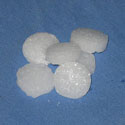Many homeowners and gardeners think of mothballs as a quick fix when trying to control indoor pest problems or wildlife incursions. There are problems with using mothballs for this purpose.
Mothballs are made up of Naphthalene. The EPA has the following statement about Naphthalene, the active ingredient in mothballs:
[notice]”Naphthalene is associated with hemolytic anemia, damage to the liver, and neurological damage. Cataracts have also been reported in workers acutely exposed to naphthalene by inhalation and ingestion. Chronic (long-term) exposure of workers and rodents to naphthalene has been reported to cause cataracts and damage to the retina. Hemolytic anemia has been reported in infants born to mothers who “sniffed” and ingested naphthalene (as mothballs) during pregnancy. Available data are inadequate to establish a causal relationship between exposure to naphthalene and cancer in humans. EPA has classified naphthalene as a Group C, possible human carcinogen.” Source: epa.gov website [/notice]
The use of mothballs in gardens or around the house to deter nuisance wildlife is problematic at best; harmful to pets, children and adults at worst. When mothballs are placed outdoors they can contaminate edible garden crops, runoff into ponds, streams and lakes and leach into ground water as a pollutant.
Here are a few things to consider when using moth balls:
-
Outside use of these products is prohibited
-
Applications are limited to an airtight space or well sealed container such as a garment bag.
-
Application locations not listed on the label, and therefore not allowed, include
-
attics
-
walls
-
voids
-
crawl spaces
-
gardens
-
closets
-
plastic garbage bags.
-
Moth balls are a pesticide and regulated by the U.S. Environmental Protection Agency (EPA) and the Florida Department of Agriculture and Consumer Services (FDACS). Contact information: FDACS (850) 617-7882, National Pesticide Information Center (800) 858-7378, Poison Control Center (800) 222-1222, Florida Department of Health, Bureau of Epidemiology, Pesticide Surveillance Program (800) 606-5810.
- Woodland Pinkroot Adds Vibrant Color to Spring Landscapes - April 27, 2023
- Easy Care Roses for the Gulf South - April 20, 2023
- Herb Gardening: When Oregano is Flavorless - March 9, 2023

